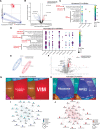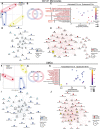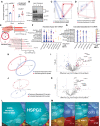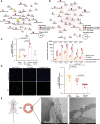Directional Endothelial Communication by Polarized Extracellular Vesicle Release
- PMID: 38174557
- PMCID: PMC10826926
- DOI: 10.1161/CIRCRESAHA.123.322993
Directional Endothelial Communication by Polarized Extracellular Vesicle Release
Abstract
Background: Extracellular vesicles (EVs) contain bioactive cargo including miRNAs and proteins that are released by cells during cell-cell communication. Endothelial cells (ECs) form the innermost lining of all blood vessels, interfacing with cells in the circulation and vascular wall. It is unknown whether ECs release EVs capable of governing recipient cells within these 2 separate compartments. Given their boundary location, we propose ECs use bidirectional release of distinct EV cargo in quiescent (healthy) and activated (atheroprone) states to communicate with cells within the circulation and blood vessel wall.
Methods: EVs were isolated from primary human aortic ECs (plate and transwell grown; ±IL [interleukin]-1β activation), quantified, visualized, and analyzed by miRNA transcriptomics and proteomics. Apical and basolateral EC-EV release was determined by miRNA transfer, total internal reflection fluorescence and electron microscopy. Vascular reprogramming (RNA sequencing) and functional assays were performed on primary human monocytes or smooth muscle cells±EC-EVs.
Results: Activated ECs increased EV release, with miRNA and protein cargo related to atherosclerosis. EV-treated monocytes and smooth muscle cells revealed activated EC-EV altered pathways that were proinflammatory and atherogenic. ECs released more EVs apically, which increased with activation. Apical and basolateral EV cargo contained distinct transcriptomes and proteomes that were altered by EC activation. Notably, activated basolateral EC-EVs displayed greater changes in the EV secretome, with pathways specific to atherosclerosis. In silico analysis determined compartment-specific cargo released by the apical and basolateral surfaces of ECs can reprogram monocytes and smooth muscle cells, respectively, with functional assays and in vivo imaging supporting this concept.
Conclusions: Demonstrating that ECs are capable of polarized EV cargo loading and directional EV secretion reveals a novel paradigm for endothelial communication, which may ultimately enhance the design of endothelial-based therapeutics for cardiovascular diseases such as atherosclerosis where ECs are persistently activated.
Keywords: RNA-seq; atherosclerosis; microRNA; monocytes; muscle, smooth; proteomics.
Conflict of interest statement
Figures








References
-
- Vanhoutte PM, Shimokawa H, Feletou M, Tang EH. Endothelial dysfunction and vascular disease - a 30th anniversary update. Acta Physiol (Oxf). 2017;219:22–96. doi: 10.1111/apha.12646 - PubMed
-
- Cines DB, Pollak ES, Buck CA, Loscalzo J, Zimmerman GA, McEver RP, Pober JS, Wick TM, Konkle BA, Schwartz BS, et al. . Endothelial cells in physiology and in the pathophysiology of vascular disorders. Blood. 1998;91:3527–3561. doi: 10.1182/blood.V91.10.3527 - PubMed
-
- Deanfield JE, Halcox JP, Rabelink TJ. Endothelial function and dysfunction: testing and clinical relevance. Circulation. 2007;115:1285–1295. doi: 10.1161/CIRCULATIONAHA.106.652859 - PubMed
-
- Gao Y, Galis ZS. Exploring the role of endothelial cell resilience in cardiovascular health and disease. Arterioscler Thromb Vasc Biol. 2021;41:179–185. doi: 10.1161/ATVBAHA.120.314346 - PubMed
Publication types
MeSH terms
Substances
Grants and funding
LinkOut - more resources
Full Text Sources
Medical
Molecular Biology Databases

